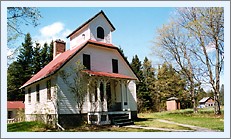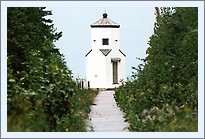 |
 |
 |
| Click thumbnails to view enlarged images | ||
| Baileys Harbor Range Lights | Seeing The Light |
|
|
|
|
Historical
Information
In 1849, working parties established logging and mining camps in the area, and 2,500 cords of lumber were shipped from the harbor. The following year, a group of log cabins were built in a cluster on the shore, and a road was cut from the harbor to the Green Bay shoreline. Thus the first village in the Door Peninsula grew on the shores of what had come to be known as "Bailey's harbor."
In 1867 the Inspector for the 11th Lighthouse District reported that the approach to the harbor was extremely difficult due to the numerous shoals at the harbor's entrance, and proposed that range lights be constructed on the west shore in order to make safe entrance easier. On July 20th of the following year, Congress appropriated $6,000 for the construction of a pair of lights, and a Lighthouse Board construction crew arrived to begin construction in the summer of 1869.
With work on the rear range light complete, the crew then began construction of the front range light, located some nine hundred feet towards the shore. While from all practical purposes the structure could have been a simple square tower, however the Lighthouse Board elected to adorn the building with an eight foot by eight foot square footprint at ground level, transitioning to an octagonal cross section at a point twelve feet above the ground. Once again, a window was placed on the side facing the lake from which the fixed red Fifth Order Fresnel lens could be seen from the lake. In order to allow the keeper to observe the lamp from within the rear range light, and to keep an eye on the rear range light when working within the front range light, a small window was also installed at the rear of the tower. At a total height of twenty-one feet, the light the lens sat at a focal plane of twenty-three feet, as a result of it's position on the shore Fabian Trudell, the first keeper of the Bailey's Harbor range lights, proudly exhibited them for the first time at the opening of the 1870 navigation season. Sitting at a focal plane of thirty-nine feet, the rear range light was seventeen feet higher than the twenty two-foot focal plane of the front range light. Thus, by design, vessels seeing the lights from the lake could steer to a point at which the white light of the rear range was directly above the red light of the front range, maintaining this heading, safe passage was guaranteed to vessels all the way into the harbor.
In 1930, both lights were electrified,
and the Immanuel Lutheran Church of Baileys Harbor was granted
permission to use the rear range keepers dwelling as a parsonage. In
1934, permission was granted to the Door County Park Commission to use
the lighthouse grounds, and thus the grounds were incorporated into the
Ridges Sanctuary in 1937. In November 1969, both range lights were
decommissioned when a Coast Guard crew removed the illuminating
equipment and constructed a metal tower with a single directional light
to the south of the front range light. |